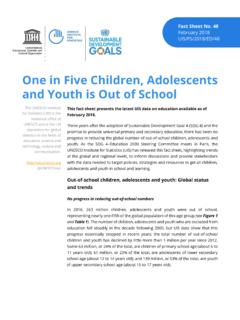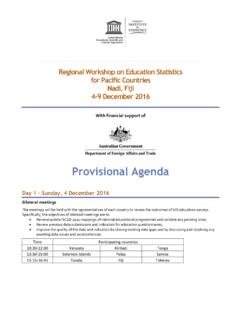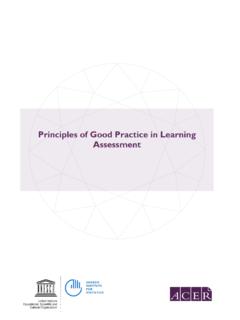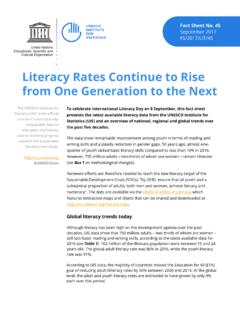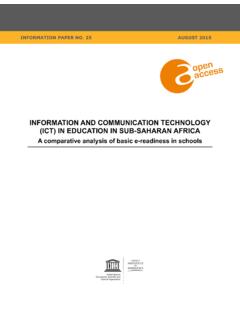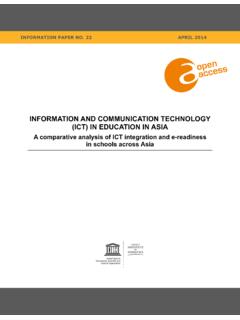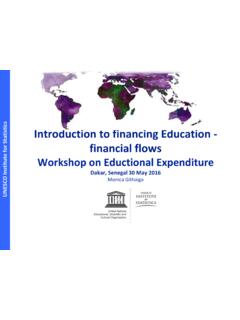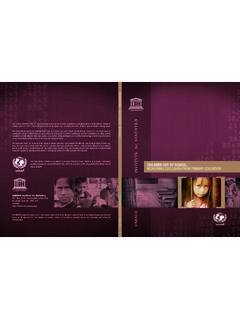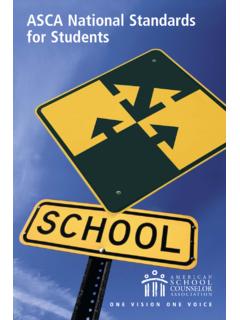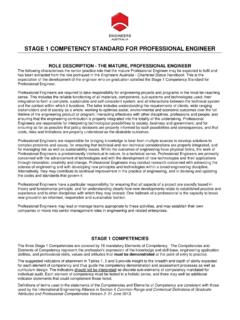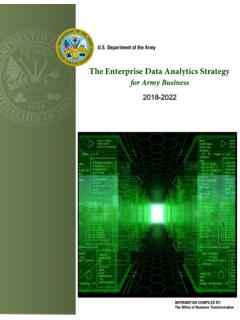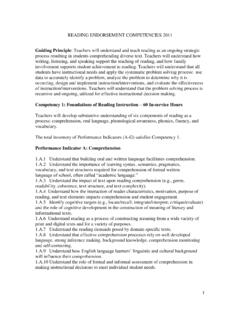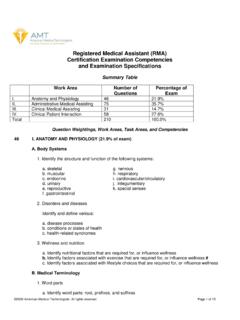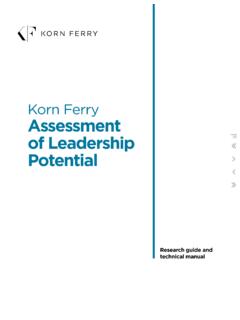Transcription of Functional literacy and numeracy - UNESCO
1 Functional literacy and numeracy : Definitions and options for measurement for the SDG Target November 2017 DRAFT NOT FOR DISTRIBUTION Abstract The Sustainable Development Goals specify a need to measure the literacy and numeracy levels of the adult population 15 and over. This report recommends definitions for literacy and numeracy and proposes a strategy for monitoring progress. Prepared by: T. Scott Murray DataAngel Policy Research Incorporated GAML4/REF/15 2 Functional literacy and numeracy : Definitions and options for measurement for the SDG Target Executive summary The Sustainable Development Goal target : states that By 2030, ensure that all youth and a substantial proportion of adults, both men and women, achieve literacy and numeracy .
2 The global indicator for the Target , and the only indicator for this target directly related to the measurement of learning outcomes, is the indicator , which states: the percentage of the population in a given age group achieving at least a fixed level of proficiency in Functional (a) literacy and (b) numeracy skills. The target age group for this indicator is the population of 15 years and older. This report recommends that the literacy and numeracy indicators be based upon the definitions of literacy and numeracy used in the OECD s PIAAC adult skill assessment program. These definitions are precise enough to be measured and broad enough to capture the entire range of skill encountered globally.
3 Although the PIAAC assessment was only administered to 16 to 65 year olds, the ALL assessment included all adults 16 and over. Analysis of results for the ALL countries confirms that the test works equally well in older populations. The report also proposes a strategy for monitoring progress, one that offers countries a range of options. Countries on their way to achieving universal secondary education are encouraged to participate in the next round of PIAAC data collection scheduled for 2021. The PIAAC design and processes are based upon 35 years of development and yield results that are valid, reliable, comparable and interpretable.
4 For countries below this level of educational development, the current PIAAC design offers a quite limited information return on their investment. Moreover, the technical, operational and financial burdens imposed by PIAAC may be too great for some countries to bear, something that translates into a non-negligible risk of catastrophic failure. Where this is the case, it is recommended that countries reduce the technical, operational and financial burden of PIAAC participation by: Switching collection entirely to computer-based methods Administering a fully adaptive test that provides equally reliable proficiency estimates over most of the two established PIAAC proficiency scales.
5 literacy and numeracy Employing purposive sampling to generate estimates of the probability of key population sub-groups being at each proficiency level and then using these probabilities to impute proficiency scores onto their 2021 Census of Population (DataAngel, 2012; CLLN, 2014). These synthetic proficiency estimates have been shown to be sufficiently precise and reliable to inform the full range of national and international policy questions through comparison to the PIAAC estimates. Where countries are unwilling or unable to collect data in the current cycle, UNESCO should generate model-based estimates using the probabilities observed in comparator countries.
6 This will ensure that measured progress reflects more than changes in the coverage of the countries for which data is available. GAML4/REF/15 3 Functional literacy and numeracy : Definitions and options for measurement for the SDG Target 1. INTRODUCTION 4 2. THE CONCEPTUAL EVOLUTION OF literacy AND numeracy 5 3. THE USES AND USERS OF COMPARATIVE literacy AND numeracy ASSESSMENT RESULTS 7 4. DEFINITIONS OF Functional literacy AND numeracy 15 5. THE WAY FORWARD: RECOMMENDATIONS FOR DEFINITIONS AND MEASUREMENT 17 6. AVAILABILITY OF THE RANGE OF ITEMS FROM DIVERSE ADULT literacy ASSESSMENTS THAT COULD BE USED TO REPRESENT THE MEASURE OF ADULT Functional LIFE SKILLS AND COMPETENCIES AND COULD BE USED TO BENCHMARK MINIMUM PROFICIENCY LEVEL 25 7.
7 IDENTIFICATION OF MEASUREMENT OPTIONS 28 8. RECOMMENDATIONS FOR THE WAY FORWARD: A SUMMARY 33 ANNEX A: REFERENCES 38 ANNEX B RECENTLY APPLIED DEFINITIONS OF literacy 39 GAML4/REF/15 4 Functional literacy and numeracy : Definitions and options for measurement for the SDG Target 1. Introduction This report provides recommendations regarding the definition of literacy and numeracy that should be adopted in support of Sustainable Development Goal target : By 2030, ensure that all youth and a substantial proportion of adults, both men and women, achieve literacy and numeracy . This objective is met through a review of the related literature, including a review of the definitions that have been employed in recent national and international attempts at measurement.
8 The report also proposes recommendations with respect to a measurement strategy that supports the goal. The global indicator for the Target , and the only indicator for this target directly related to the measurement of learning outcomes, is the indicator , which states: The percentage of the population in a given age group achieving at least a fixed level of proficiency in Functional (a) literacy and (b) numeracy skills. The target age group for this indicator is the population of 15 years and older. This objective is met through a review of how the definition of literacy has evolved over the past three decades, of the criteria needing to be met to support the intended uses of the assessment data and how current approaches might be relaxed to reduce the technical, operational and financial burden without compromising the intended uses of the data.
9 GAML4/REF/15 5 Functional literacy and numeracy : Definitions and options for measurement for the SDG Target 2. The conceptual evolution of literacy and numeracy Chapter 6 of the Education for All Global Monitoring Report of 2006 provides a useful summary of how the concept of literacy and numeracy has evolved significantly over the past 40 years. In the 1970 s UNESCO defined literacy indirectly by associating skill with years of formal education. More specifically, individuals were judged to be functionally literate if they attended 4 years of education and to be fully literate if they attended 9 years of education.
10 UNESCO also relied on self-reports of literacy and upon the administration of a simple reading passage in the context of the Census of Population. Theoretical developments related to the definition and measurement of literacy and numeracy in the United States were applied in the 1985 US YALS, the 1987 Canadian LSUDA and the 1990 US NALS assessments. These developments advanced the notion of literacy and numeracy skill as continua rather than dichotomies, and documented that the relative difficulty of reading and numeracy tasks were largely a function of the cognitive demands of the task rather than the text or operation being undertaken.
